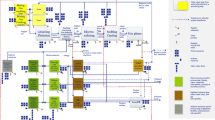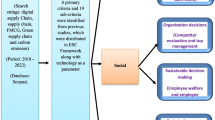Abstract
Purpose
The purpose of this work was to develop an indicator framework for the environmental sustainability benchmarking of products produced by the metallurgical industry. Sustainability differentiation has become an important issue for companies throughout the value chain. Differentiation is sometimes not attainable, due to the use of average data, lack of comparative data, certain issues being overshadowed by others, and a very narrow palette of indicators dominating the current sustainability assessments. There is a need for detailed and credible analyses, which show the current status and point out where improvements can be made. The indicator framework is developed to give a comprehensive picture of eco-efficiency, to provide methods that enable relevant comparisons as well as the tools for communicating the results. In this way, the methodology presented in this study aims to make differentiation easier and thus aid companies in driving the development toward more sustainable solutions.
Methods
The framework is based on the existing indicator framework Gaia Biorefiner, which is primarily intended for bio-based products. In this work, the framework was further developed for application in the metallurgical industry. The indicator framework is built by first looking at the issues, which are critical to the environment and global challenges seen today and which the activities of the metallurgical industry may have an impact on. Based on these issues, suitable indicators are chosen if they exist and built if they do not. The idea is that all indicators in a group form a whole, showing areas of innovation while refraining from aggregating and weighting, which often compromise a comprehensive and objective view. Both qualitative and quantitative indicators are included. The indicators are constructed following the criteria set by the EU and OECD for building indicators. Each indicator further has a benchmark. The rules for building the benchmark are connected to the indicators. Suitable data sources and criteria for the benchmark and the indicators are gathered from literature, publicly available databases, and commercial LCA software. The use of simulation tools for attaining more reliable data is also studied.
Results and discussion
The result is a visual framework consisting of ten indicator groups with one to five indicators each, totaling up to 31 indicators. These are visualized in a sustainability indicator “flower.” The flower can be further opened up to study each indicator and the reasons behind the results. The sustainability benchmark follows a methodology that is based on utilization of baseline data and sustainability criteria or limits. A simulation approach was included in the methodology to address the problem with data scarcity and data reliability. The status of the environment, current production technologies, location-specific issues, and process-specific issues all affect the result, and the aim of finding relevant comparisons that will support sustainability differentiation is answered by a scalable scoping system.
Conclusions
A new framework and its concise visualization has been built for assessing the eco-efficiency of products from the metallurgical industry, in a way that aims to answer the needs of the industry. Since there is a baseline, against which each indicator can be benchmarked, a sustainability indicator “flower” can be derived, one of the key innovations of this methodology. This approach goes beyond the usual quantification, as it is also scalable and linked to technology and its fundamental parameters. In part 2, a case study “A case study from the copper industry” tests and illustrates the methodology.







Similar content being viewed by others
Notes
The indicator goes beyond the blue water footprint, which only considers the volume of surface and groundwater evaporated or incorporated into a product. The blue water footprint is the amount of water withdrawn from groundwater or surface water that does not return to the source from which it was withdrawn.
References
Azapagic A (2004) Developing a framework for sustainable development indicators for the mining and minerals industry. J Clean Prod 12:639–662
BGS (2012). Risk list 2012—current supply risk for chemical elements or element groups which are of economic value. British Geological Survey. http://www.bgs.ac.uk/mineralsuk/statistics/risklist.html. Accessed 23 Jan 2015
Bringezu S, Schütz H, Moll S (2003) Rationale for and interpretation of economy-wide materials flow analysis and derived indicators. J Ind Ecol 7(2):43–64
Bukhard (2009) Landscapes’ capacities to provide ecosystem services—a concept for land-cover based assessments. Landsc Online 15:1–22
Bukhard (2014) Ecosystem service potentials, flows and demands—concepts for spatial localisation, indication and quantification. Landsc Online 34:1–32
Derwall J, Guenster N, Bauer R, Koedijk K (2005) The eco-efficiency premium puzzle. Financ Analysts J 61:2
DeSimone LD, Popoff F, World Business Council for Sustainable Development (1997) Eco-efficiency: the business link to sustainable development. MIT, Cambridge
European Union (2015). EU resource efficiency scoreboard, 2014. http://ec.europa.eu/environment/resource_efficiency/documents/re_scoreboard_2014.pdf. Accessed 17 Aug 2016
European Commission (2008) Waste framework directive (Directive 2008/98/EC)
European Commission (2009) The fuel quality directive. (Directive 2009/30/EC)
European Commission (2009) The renewable energy directive. (Directive 2009/28/EC)
European Commission (2011) COM(2011) 21 communication from the Commission to the European Parliament, the Council, the European Economic and Social Committee and the Committee of the Regions. A resource-efficient Europe—flagship initiative under the Europe 2020 strategy
European Commission (2014) Annexes to the report on critical raw materials for the EU. Report of the Ad Hoc Working Group on defining critical raw materials. http://ec.europa.eu/growth/sectors/raw-materials/specific-interest/critical/index_en.htm Accessed 6 Feb 2015
European Commission (2014) Best available techniques (BAT) reference document for the non-ferrous metals industries, draft, Joint Research Centre: Institute for Prospective Technological Studies, Sustainable Production and Consumption Unit, European IPPC Bureau
Fizal T (2007) An environmental assessment method for cleaner production technologies. J Clean Prod 15:914–919
Fussler C, James P (1996) Driving eco-innovation: a breakthrough discipline for innovation and sustainability. Pitman, London
Goedkoop M, Spriensma R (2004) The eco-indicator 99—a damage oriented method for life cycle assessment, methodology report, PRé Consultants
Goedkoop M, Heijungs R, Huijbregts M, De Schryver A, Struijs J, Van Zelm R (2013) ReCiPe 2008, a life cycle impact assessment method which comprises harmonised category indicators at the midpoint and the endpoint level, first edition, Report I: Characterisation. s.l.: RIVM Report
Hoekstra AY, Mekonnen MM, Chapagain AK, Mathews RE, Richter BD (2012) Global monthly water scarcity: blue water footprints versus blue water availability. PLoS One 7(2):e32688. doi:10.1371/journal.pone.0032688
Huysman S, Sala S, Mancini L, Ardente F, Alvarenga RAF, De Meester S, Mathieux F, Dewulf J (2015) Toward a systematized framework for resource efficiency indicators. Indic, Resour, Conserv Recycl 95:68–76
IChemE (2002) The sustainability metrics. The Institution of Chemical Engineers, Rugby
IPCC (2013) Climate change 2013: the physical science basis. In: Stocker TF, Qin D, Plattner G-K, Tignor M, Allen SK, Boschung J, Nauels A, Xia Y, Bex V, Midgley PM (eds) Contribution of working group I to the fifth assessment report of the intergovernmental panel on climate change. Cambridge University Press, Cambridge, 1535 pp
ISO (International Standards Organisation) (2006) ISO14044: environmental management—life cycle assessment—requirements and guidelines
ISO (International Standards Organisation) (2006) ISO14040: environmental management—life cycle assessment—principles and framework
Khan F, Sadiq R, Veitch B (2004) Life Cycle iNdeX (LInX): a new indexing procedure for process and product design and decision-making. J Clean Prod 12:59–76
Mancini L, Sala S, Recchioni M, Benini L, Goralczyk M, Pennington D (2015) Potential of life cycle assessment for supporting the management of critical raw materials. Int J Life Cycle Assess 20:100–116
Nelen D, Manshoven S, Peeters JR, Vanegas P, D’Haese N, Vrancken K (2014) A multidimensional indicator set to assess the benefits of WEEE material recycling. J Clean Prod 83:305–316
OECD (Organisation for Economic Cooperation and Development) (2003) OECD environmental indicators development, measurement and use, reference paper
Remus R, Monsonet MAA, Roudier S, Delgado Sancho L (2013) Joint Research Council. best available techniques (BAT) reference document for iron and steel production, European Commission
Reuter MA (1998) The simulation of industrial ecosystems. Miner Eng 11(10):891–917
Reuter MA, Hudson C, van Schaik A, Heiskanen K, Meskers C, Hagelüken C (2013) Metal recycling, opportunities, limits, infrastructure, UNEP united nations environmental programme, report for International Resource Panel: http://www.unep.org/resourcepanel/Portals/50244/publications/Metal_Recycling-Full_Report_150dpi_130919.pdf
Reuter MA, van Schaik A, Gediga J (2015a) Simulation-based design for resource efficiency of metal production and recycling systems: cases—copper production and recycling, e-waste (LED lamps) and nickel pig iron. Int J Life Cycle Assess 20(5):671–693
Reuter MA, Matusewicz R, van Schaik A (2015b) Lead, zinc and their minor elements: enablers of a circular economy. World Metall-Erzmetall 68(3):132–146
Ridoutt BG, Pfister S (2010) A revised approach to water footprinting to make transparent the impacts of consumption and production on global freshwater scarcity. Glob Environ Chang 20(1):113–120
Sala S, Goralczyk M (2013) Chemical footprint: a methodological framework for bridging life cycle assessment and planetary boundaries for chemical pollution. Integr Environ Assess Manag 9(4):623–632
Sala S, Farioli F, Zamagni A (2013) Progress in sustainability science: lessons learnt from current methodologies for sustainability assessment: part 1. Int J Life Cycle Assess 18:1653–1672
Saling P, Kicherer A, Dittrich-Krämer B, Wittlinger R, Zombik W, Schmidt I, Schrott W, Schmidt S (2002) Eco-efficiency analysis by BASF: the method. Int J Life Cycle Assess 7(4):203–218
Schlesinger ME, King M, Sole K, Davenport W (2011) Extractive metallurgy of copper, 5th edn. Elsevier, New York
Schmidheiny S (1992) Changing course: a global business perspective on development and the environment. MIT Press
Singh RK, Murty HR, Gupta SK, Dikshit AK (2012) An overview of sustainability assessment methodologies. Ecol Ind 15:281–299
UNEP (United Nations Environmental Programme) (2008) Vital water graphics: an overview of the state of the world’s fresh and marine waters—2nd ed
Van Schaik A, Reuter MA (2014) Chapter 22: material-centric (aluminium and copper) and product-centric (Cars, WEEE, TV, Lamps, Batteries, Catalysts) recycling and DfR rules. In: Worrel E, Reuter MA (eds) Handbook of recycling. Elsevier, 307–378
Vieira MDM, Goedkoop MJ, Storm P, Huijbregts MAJ (2012) Ore grade decrease as life cycle impact indicator for metal scarcity: the case of copper. Environ Sci Technol 46:12772–12778
WEF (World Economic Forum) (2016) The global risk report 2016, 11th edn. Available at http://wef.ch/risks2016
Worrel E, Reuter M (2014) Handbook of recycling, state-of-the-art for practitioners, analysts, and scientists. Elsevier, Waltham
Author information
Authors and Affiliations
Corresponding author
Ethics declarations
Funding
This study was funded by Outotec Oyj and Gaia Consulting Oyj. HSC Sim is a product of Outotec Oyj and Gaia Refiner is a product of Gaia Consulting Oy.
Additional information
Responsible editor: Adisa Azapagic
Electronic supplementary material
Below is the link to the electronic supplementary material.
Table S1
(DOCX 18 kb)
Rights and permissions
About this article
Cite this article
Rönnlund, I., Reuter, M., Horn, S. et al. Eco-efficiency indicator framework implemented in the metallurgical industry: part 1—a comprehensive view and benchmark. Int J Life Cycle Assess 21, 1473–1500 (2016). https://doi.org/10.1007/s11367-016-1122-9
Received:
Accepted:
Published:
Issue Date:
DOI: https://doi.org/10.1007/s11367-016-1122-9




